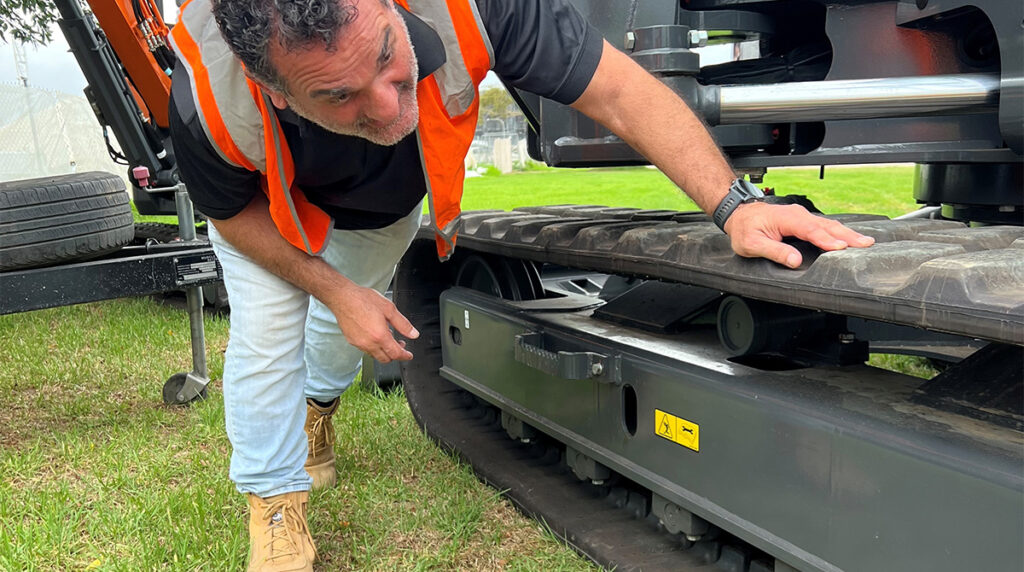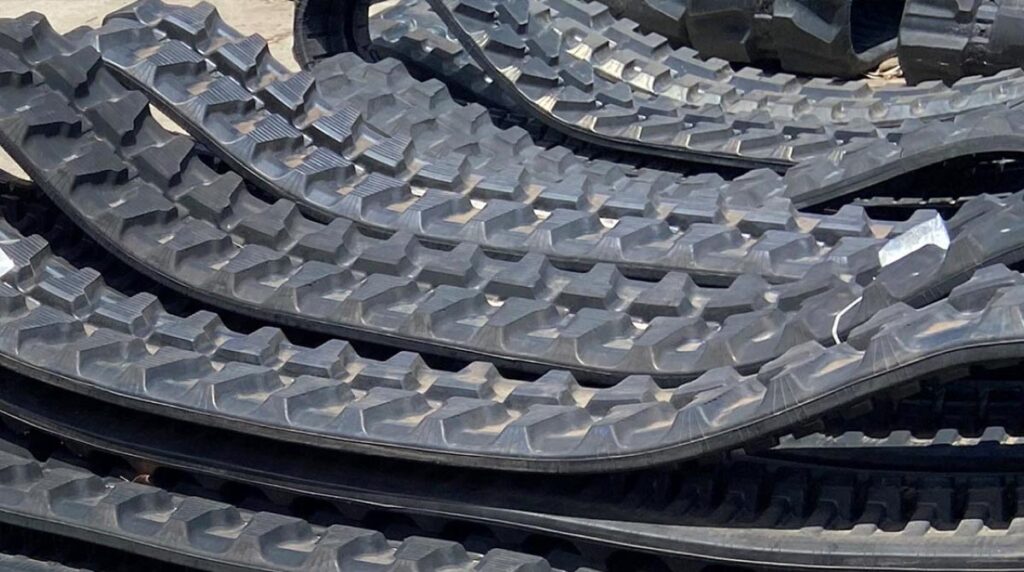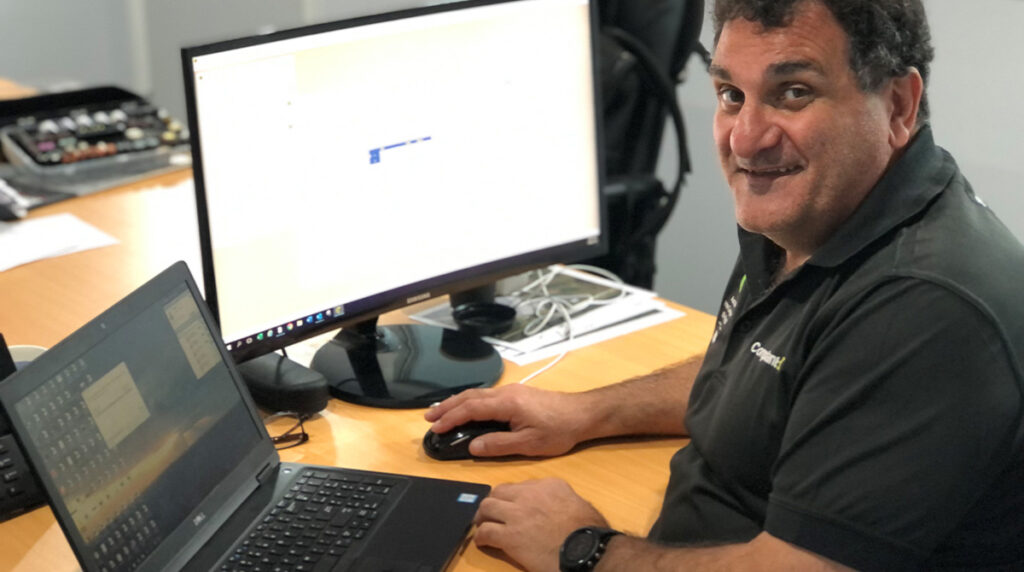Whether they’re damaged, aging or just not performing like they used to, there comes a time when you need to replace your rubber excavator tracks.
When this time comes, you want to make sure you purchase the right ones the first time around. But with the vast array of different types, sizes, tread patterns and manufacturers out there, it can be a real headache selecting the right rubber excavator track.
Getting it right saves you unnecessary costs and pointless downtime, and avoids potential damage to the undercarriage of your excavator.
What should you be looking for?
When you really get down to it, you’re looking at the type and compound of the rubber used and the steel that goes into holding it all together. It comes down to the engineering of the product, and unless you’re a chemist or have studied the art of rubber products, sometimes you just have to trust what you’re being told is correct. But not anymore!
Not all rubber excavator tracks are created equally
Having boomed in popularity for small to mid-sized excavators, manufacturers of these circular rubber belts have sprung up from seemingly nowhere, and customers are now beyond spoilt for choice.
At first, this was seen as a good thing with competitive pricing and more variations suiting different excavators and projects, giving customers more options than ever before. However, as time went on, excavator tracks that were made with good quality rubber were competing with inferior variations. To an untrained eye, the difference between top quality rubber tracks and its poorer cousins is almost impossible to see.
That’s why we’re here to help. Here’s all the crucial information to consider when it’s time to buy the right excavator track for your equipment.
Get the right rubber density - not too hard and not too soft
So whilst a lot has changed, and We could go on all day about rubber compounds – but very simply, rubber excavator tracks are made from a rubber compound that consists of base elastic polymers, fillers, and various other chemicals, all of which impact the amount of stress and strain an excavator track can withstand before failure.
Rubber is the key. It can’t be too hard or too soft – what you need to look for is a good quality compound made from the highest grade. It needs to be highly resistant to cutting, stretching, tearing, and puncturing under a wide range of uses.
The benefits for getting it right? Better tread for longer life, a higher degree of reliability and performance, and ultimately, less maintenance for your mini excavator.
How do you know if it’s the best rubber out there?
First up is the ‘sniff test’. Believe it or not, there is a distinct odour that comes off recycled rubber tracks. Just like fake leather, you can tell when it’s not the real deal. So, if it smells like a used tyre, stay well away and you’ll avoid a headache later on.
Second is the ‘appearance test’. Look for tracks that are solid in colour with a nice dark appearance throughout the entire track. If it doesn’t have this or there are gaps in colour, chances are it’s made with recycled rubber.
A bonus tip is to have a conversation with your supplier of excavator pads, tracks and buffers. If they’re worth their salt, their reputation and relationship with you are more important than simply getting stock out the door. So, when it comes to rubber, don’t be afraid to chat about your specific needs and uses as part of the selection process because it’s the rubber that protects and holds everything else together.
And remember, you get what you pay for.
Always look to buy rubber excavator tracks with steel belts & metal inserts.
Top quality rubber is one thing, but the inserts and wires that hold everything together are just as important.
Think of rubber tracks as a series of multiple layers. Each layer is designed to play an important role in the longevity, durability, and the performance over the life of the rubber track. Just like poor-quality rubber, using inferior materials for inserts and wires can have serious consequences sooner than you think.
In addition to rubber, excavator tracks also consist of:
- Metal inserts: the primary purpose of the metal inserts is to engage with the sprocket resulting in movement.
- Steel core wires: the core wires provide strength and rigidity throughout the length of the track.
In addition to inspecting the rubber when you’re shopping for rubber trackpads, we recommend that you also check the metal inserts. Ensure that the inserts are made of one piece of forged metal, as this will allow the rubber track to stand up to the weight and movement of the machine, even at maximum working conditions across uneven terrains.
If the insert has multiple joining points, stay away. Multiple joining points means multiple weak points, which means more chances or failure. One-piece forging, however, doesn’t have this problem. In fact, one-piece forging results in extreme durability and performance, and a longer service life for your construction equipment.
It’s also important for a continuous cable to be wrapped around the length of the track, as it will provide much better strength and longevity when compared to separate lengths being joined together. Like mentioned above, separate lengths joined together creates a multitude of unnecessary weak points, and that’s a concern you don’t want when using an excavator.
The continuous cable technique will also provide greater flexibility, ensuring the track will withstand tough working conditions such as rock and other abrasive environments when compared to overlapping steel belts.
Get the right size and the right tread pattern.
An area that is often overlooked when people buy rubber excavator tracks is getting the correct track size and tread pattern.
Purchasing the right size sounds simple enough, right? However, with the growing complexity of track systems and sizes available across a wide range of excavators, purchasing the wrong size track is common, and not always apparent immediately.
As tracks stretch and wear over time, a minor measurement error can result in premature failure of the track. It can also cause potential damage to the undercarriage, including your sprockets, which becomes quite a costly affair. So when it comes to size, it’s not simply how big or small the rubber track is – it needs to be the right length, width, links and pitch to match the machine’s sprockets to ensure the correct tension when fitted.
Here’s a quick breakdown to understand what to look for when measuring the size of a rubber excavator track:
- Width/length: this is the overall width and length of the track
- Pitch: the spacing between the centre of the metal inserts (Long or Short)
- Links: the number of metal inserts or links in the track
Found the right size track? Now comes the fitting
Our tip when fitting is to avoid overtightening. The rubber track can break through premature wear (this also results in greater use of fuel). If it’s too loose, the rubber track will actually run off – either way resulting in unnecessary expense.
Worried you’ll get the wrong track size for your excavator? Not a problem. Your local supplier has all the information you need to make sure your excavator is well-equipped for the task at hand. And if they can’t, we recommend sourcing an alternative supplier. Otherwise, chances are you’ll end up with a dud.
You also need to ensure you select the right tread pattern. Tread pattern, like a car tyre, can be the difference between a smooth or rough ride, overall traction, and ground disturbance. When considering the tread, it’s important to buy rubber excavator tracks for the surface the machine will be used on the most.
Considering the terrain can be as simple as understanding the subtle difference between operating on aggressive or soft material such as lawns, mud, concrete, or gravel, and picking tread that is going to cause the least amount of disturbance.
Get the wrong tread for the wrong terrain and you’re in for a rough ride. You’ll have excessive noise throughout the cabin and increased levels of vibration, which aren’t just uncomfortable – they’ll increase wear and tear on your excavator and impact its overall performance.
As you can see there are a number of areas to consider when buying rubber excavator tracks. Each plays a major role in the longevity of your rubber tracks and their overall performance across the worksite.
By ensuring:
- The right tread pattern is selected, based on your intended use,
- You’ve got the right size,
- The right materials are used in the manufacturing process, including 100% virgin rubber, one-piece forged metal inserts and continuous cables;
You’ll be able to work with confidence knowing you’ve got the best rubber excavator tracks underneath you.
Need advice on buying the right rubber excavator track for your machine? Have a chat with the team at TrackPads Australia. They stock a huge range of tracks, pads and buffers, and can size your machine up no worries. Find out more here.



